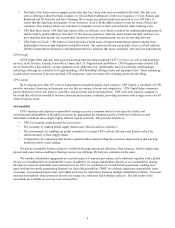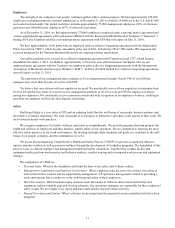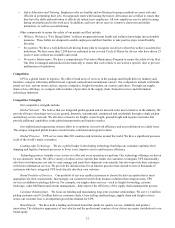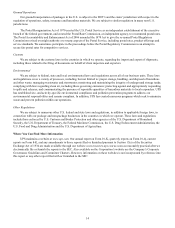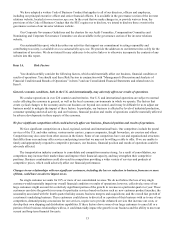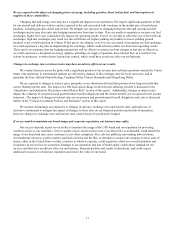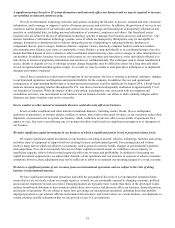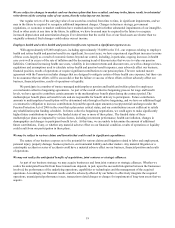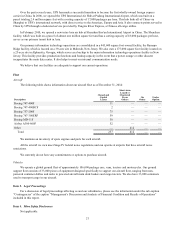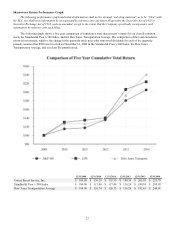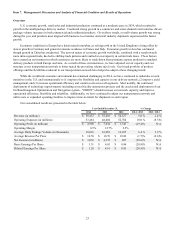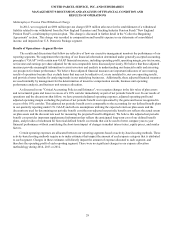UPS 2014 Annual Report Download - page 31
Download and view the complete annual report
Please find page 31 of the 2014 UPS annual report below. You can navigate through the pages in the report by either clicking on the pages listed below, or by using the keyword search tool below to find specific information within the annual report.19
We are subject to changes in markets and our business plans that have resulted, and may in the future result, in substantial
write-downs of the carrying value of our assets, thereby reducing our net income.
Our regular review of the carrying value of our assets has resulted, from time to time, in significant impairments, and we
may in the future be required to recognize additional impairment charges. Changes in business strategy, government
regulations, or economic or market conditions have resulted and may result in further substantial impairments of our intangible,
fixed or other assets at any time in the future. In addition, we have been and may be required in the future to recognize
increased depreciation and amortization charges if we determine that the useful lives of our fixed assets are shorter than we
originally estimated. Such changes could reduce our net income.
Employee health and retiree health and pension benefit costs represent a significant expense to us.
With approximately 435,000 employees, including approximately 354,000 in the U.S., our expenses relating to employee
health and retiree health and pension benefits are significant. In recent years, we have experienced significant increases in some
of these costs, largely as a result of economic factors beyond our control, including, in particular, ongoing increases in health
care costs well in excess of the rate of inflation and the decreasing trend of discount rates that we use to value our pension
liabilities. Continued increasing health care costs, volatility in investment returns and discount rates, as well as changes in laws,
regulations and assumptions used to calculate retiree health and pension benefit expenses, may adversely affect our business,
financial position, results of operations or require significant contributions to our pension plans. The new national master
agreement with the Teamsters includes changes that are designed to mitigate certain of these health care expenses, but there can
be no assurance that our efforts will be successful or that the failure or success of these efforts will not adversely affect our
business, financial position, results of operations or liquidity.
We participate in a number of trustee-managed multiemployer pension and health and welfare plans for employees
covered under collective bargaining agreements. As part of the overall collective bargaining process for wage and benefit
levels, we have agreed to contribute certain amounts to the multiemployer benefit plans during the contract period. The
multiemployer benefit plans set benefit levels and are responsible for benefit delivery to participants. Future contribution
amounts to multiemployer benefit plans will be determined only through collective bargaining, and we have no additional legal
or constructive obligation to increase contributions beyond the agreed-upon amounts (except potential surcharges under the
Pension Protection Act of 2006 in the event that a plan enters critical status, and our contributions are not sufficient to satisfy
any rehabilitation plan funding schedule). In future collective bargaining negotiations, we could agree to make significantly
higher future contributions to improve the funded status of one or more of these plans. The funded status of these
multiemployer plans are impacted by various factors, including investment performance, health care inflation, changes in
demographics and changes in participant benefit levels. At this time, we are unable to determine the amount of additional
future contributions, if any, or whether any material adverse effect on our financial condition, results of operations or liquidity
could result from our participation in these plans.
We may be subject to various claims and lawsuits that could result in significant expenditures.
The nature of our business exposes us to the potential for various claims and litigation related to labor and employment,
personal injury, property damage, business practices, environmental liability and other matters. Any material litigation or a
catastrophic accident or series of accidents could have a material adverse effect on our business, financial position and results
of operations.
We may not realize the anticipated benefits of acquisitions, joint ventures or strategic alliances.
As part of our business strategy, we may acquire businesses and form joint ventures or strategic alliances. Whether we
realize the anticipated benefits from these transactions depends, in part, upon the successful integration between the businesses
involved, the performance of the underlying operations, capabilities or technologies and the management of the acquired
operations. Accordingly, our financial results could be adversely affected by our failure to effectively integrate the acquired
operations, unanticipated performance issues, transaction-related charges or charges for impairment of long-term assets that we
acquire.


